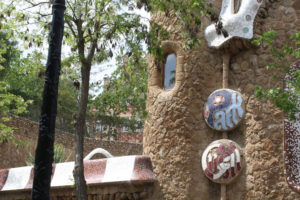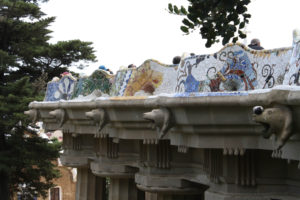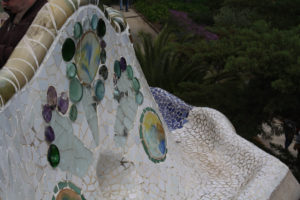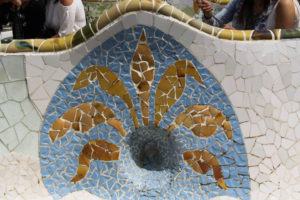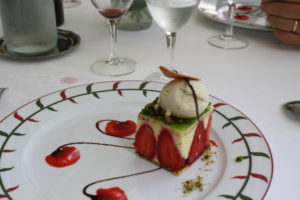Trieste…Loitering at its Best

“Trieste offers no unforgettable landmark, no universally familiar melody, no unmistakable cuisine.” Jan Morris
Why on earth would anyone go to Trieste after reading that quote from travel writer Jan Morris? Because. In fact, writers have come to Trieste for years to embrace the city’s prickly grace, savor its glistening belle époque cafes, and enjoy the lack of tourism. Having said that, the best way to experience Trieste is by loitering.
Start your day with a fantastic cup of coffee, relaxing in the Piazza dell’Unita d’Italia. After all, this is one of Europe’s greatest coffee ports, supplying more than 40% of Italy’s coffee. The thriving coffee industry began here with the Austro-Hungarian government and is still considered the coffee capital of Italy.
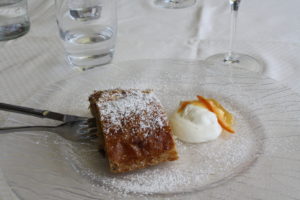
As for the Piazza, this vast public domain is supposed to be the largest square opening onto a waterfront in Italy. Dozens of cafes and bars open onto the Piazza. Sit and savor coffee in the morning, prosecco in the afternoon…or the other way around. It doesn’t matter. Watch the ships in the harbor as you listen to locals greeting each other in Triestino, the local dialect still in wide use. Enjoy a Viennese pastry with coffee or chocolate cake and nibbles with your prosecco. If it’s the hour of the passeggiata, the so Italian moment between the end of the workday and dinnertime…an entirely different scene unfolds in the Piazza. Trieste hospitality includes more nibbles with your evening prosecco. Life is good.
Trieste is a medium size seaport literally teetering on the edge of Italy, its limestone plateau gracefully tumbling into the Adriatic Sea. Its history is somewhat convoluted and Trieste has been in more than one tug of war between countries. It once was one of the oldest parts of the Habsburg Monarchy. Throughout history Trieste has been an important spot in the struggle between the Eastern and Western blocs after WWII.
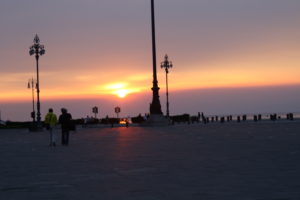
History and its influences are evident in the streets, buildings, food, and castles. Sitting in the Piazza, look at the buildings bordering the three sides of the square. With a boxy wedding cake like style, these massive buildings look like they belong in Germany…not Italy. Many streets appear to be symmetrical with buildings resembling everything from rigid, almost Teutonic in style to one showing off proud neo-Classical features. Italian flair mixed in with Germanic rigidness proves how history influenced this city. Influence of the Roman Empire remains here as well, with the Roman theatre ruins. Built between the first and second centuries AD, these were uncovered in 1938.
Of course, there’s the castle…Castello Miramare to be exact. Lying on the waterfront only five miles from the city center, this castle was built on a rocky cliff between 1856 and 1860 as the residence for Archduke Ferdinand Maximilian of Hapsburg and his wife Charlotte of Belgium. Eclectic in design is the only way to describe the features included…an aquarium like fixture in one ceiling, an impressive display of weapons, and styles throughout that combine Gothic, Renaissance, and Medieval. The 22 hectar large park with its imported soil, exotic trees, and spectacular plants and flowers from all over the world were meant to be impressive. Included on the grounds is the Castelletto, a small castle where Charlotte lived after her return from Mexico. Sadly, it is also where she was locked up after a nervous breakdown.
History didn’t forget the food, either. Most pastries are rich, flaky, and Viennese in style and taste. In fact, the local cuisine is just as diverse as the population of Trieste. German influenced sauerkraut, salt cod from the Adriatic, or local red wine…nothing stereotypical here.
Trieste…a city meant to be walked and explored. Linger…loiter…savor at a relaxed tempo. Don’t worry about the other Italian cities putting on their show of architectural splendor. Trieste is a modern city sometimes neglected by guide books. Take some time to explore this corner of Italy.
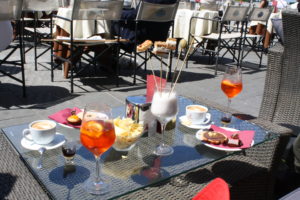
If You Go: Fly into Venice and take the two hour train ride. Once in Trieste, you can walk everywhere.





